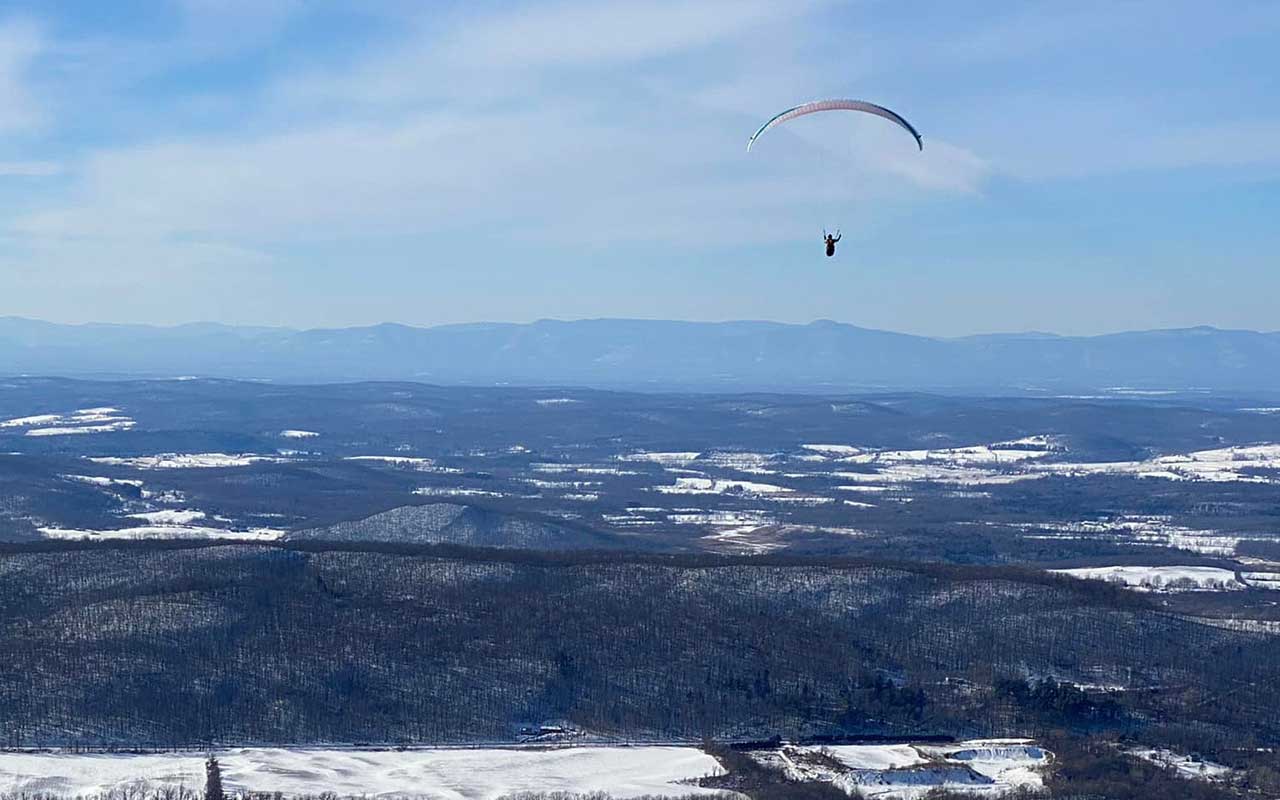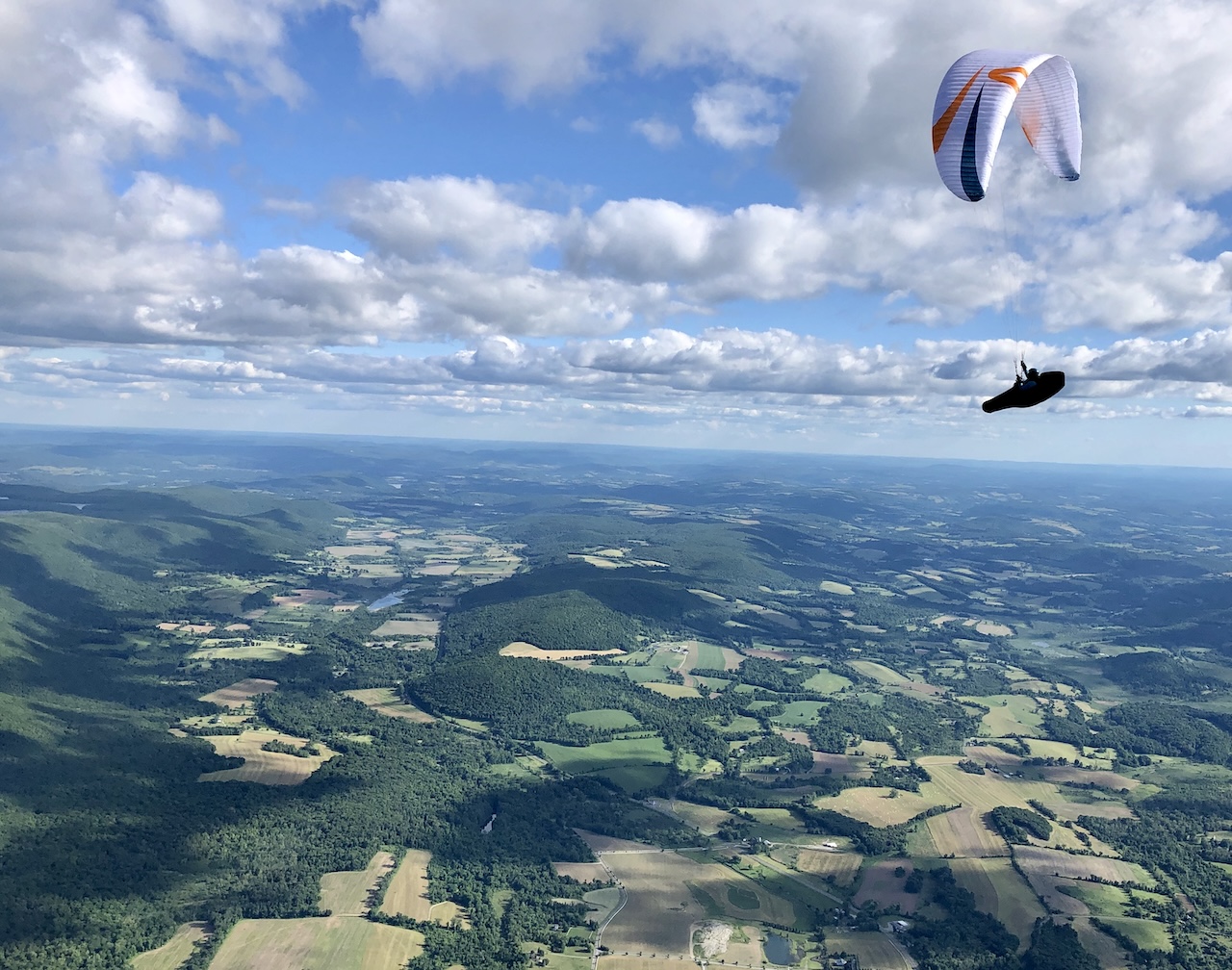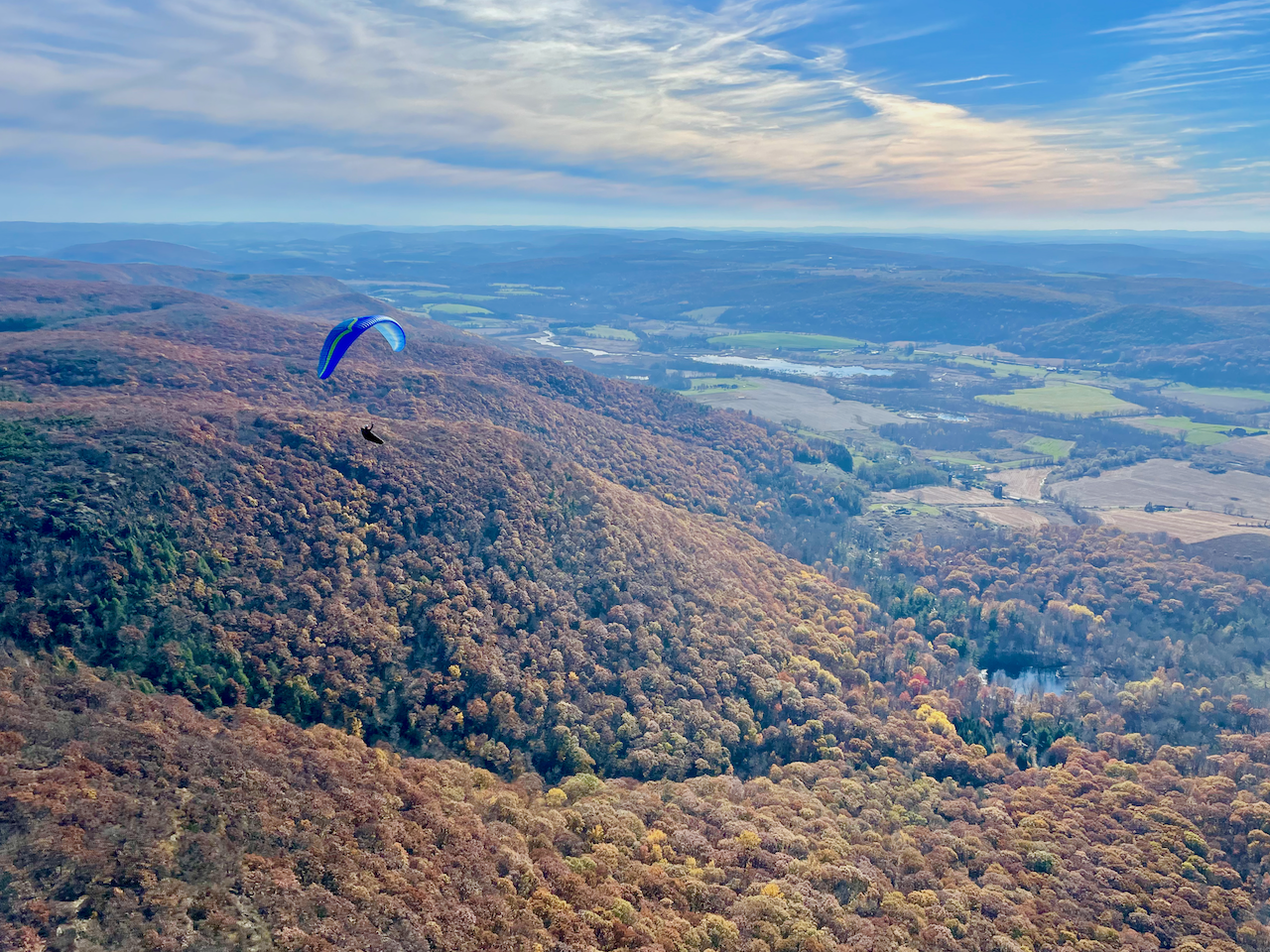This Month’s Featured Article

Flying Free at Mt. Brace
The yearning to be as free as a bird and to soar on wings in the sky has been with humankind since the dawn of time. One of the best-known legends about that lure – and the danger inherent in its pursuit – is that of the ancient Greek father and son, Daedalus and Icarus.
Daedalus, a masterful inventor, was imprisoned on Crete by King Minos for angering him. To escape this wretched condition, Daedalus crafted sets of wings from wood, feathers, and wax. Finally it was time to go. The wings worked, and he and his son flew away from the island. But Icarus, exhilarated with the flight, took off higher in the sky. His fate? The sun melted the wax, the feathers fell out, and Icarus plummeted to earth, fell into the sea, and drowned.
One can only speculate on how many attempts have been made to do what Daedalus and Icarus attempted. While we take air travel for granted today, it’s mind-boggling to think that it was just 121 years ago – 1903 – that Orville and Wilbur Wright finally succeeded in getting off the ground on a winged contraption and stayed suspended for 12 whole seconds over the sand dunes of Kitty Hawk, NC. The Soviet Luna 2 rocket landed on the surface of the moon in 1959, and ten years later, Neil Armstrong, an astronaut on the Apollo 11 mission, was the first human to walk on the moon. Air and space travel became a reality, and we sort of left the birds behind.
But being in an engine-propelled airplane doesn’t do that yearning to be a bird justice, and people will always want to fly with their own wings.
It’s happening at Taconic State Park
The members of the Mt. Brace Outdoor Club, a group of hang glider and paraglider pilots, do indeed fly off Mt. Brace. The mountain is located in Taconic State Park at the intersection of New York, Connecticut, and Massachusetts – a beautiful location for any outdoor enthusiast and also one of the best locations for free flying on the East Coast. It’s what’s been drawing flyers to the park for 50 years, since the early 1970s.
Zoe Sheehan Saldana and her partner, Joachim Roesler, are officers of the Mt. Brace Outdoor Club. Zoe is excitedly planning for a 50th anniversary celebration, tentatively on Labor Day weekend. As she explains, “Back in 1974, some intrepid humans hauled their gear up to the summit, hooked in, and flew off, landing safely about 1,500 feet below in a Boston Corner farm field.” Some of those early pilots are still soaring over Mt. Brace. They include Lee Keeler, John McNeely, Blaise Thompson, and Dale Ely. What a legacy. “The flying apparatus and community have changed with time,” Zoe says, “but the spirit of adventure and exploration continues unabated.”
Sure enough, on a day that’s suitable for flying, you may spot up to a dozen or more paragliders in the skies over Taconic State Park and beyond.
“On a good day when the weather favors us,” Zoe says, “we can stay up for hours making turns with hawks, eagles, and even butterflies as we follow thermal updrafts.” A good day depends on a lot of meteorological syncopations, and there’s a basic season that’s best, too, typically May through October, Zoe explains. “When the hummingbirds start to come out,” she says, “is when it seems the weather is settled enough to fly more regularly.”
Hawks, eagles, butterflies, even hummingbirds. Catching the wind and soaring.

A pioneer pilot
Being in the air was an obsession for Tom Peghiny, who in Junior High School was part of an aviation club whose members studied wing designs with the hope and intention of getting off the ground with something they could build. This was in the early 1970s. In the back of a magazine called Soaring, which was edited by Richard Miller, they found an ad for plans for building wings. The plans cost $5. What arrived was a set of plans designed by Miller for what were described as “bamboo butterflies.” They were based off the concept of a Rogallo wing. This was a self-inflating, flexible wing invented in 1948 by Francis Rogallo, a NASA engineer, and his wife, Gertrude, and it went on to be the prototype for early hang gliders that would launch the sport around the world in the 1970s.
Tom calls Miller the “patron saint of early hang gliders.” Miller’s butterfly “wings” were constructed from bamboo and polyethylene plastic bound with what was considered a miracle material at the time, fiberglass tape. “We built one, and by pulling it with ropes we could jump off a knoll, get airborne, and say ‘whee,’” he says. It was enough to fuel his imagination and determination to hang glide.
“When I was 15,” he recalls, “I met an aeronautical engineer who was starting a hang gliding company outside of Boston, where I grew up. I was his test pilot.” Tom literally took off with his love of free flying.
“My first real flight,” he shares, “was at Blue Hill in Milton, MA, a steep ski area. I got about 50 to 70 feet off the ground for about 20 seconds. It was transcendent.” There was no turning back.
In 1973, when he was just 17, Tom participated in the Hang Gliding National Championships in Sylmar, CA. In 1974, just after graduating from high school, Tom competed in the Hang Gliding World Championships in Kössen, Austria. “After graduation, I went right into hang gliding and aeronautics as a career, and I’ve been at it ever since.”
A wonder for wings
The Rogallo Wing was what led Zoe to the sport, as well. She was living in Brooklyn and teaching art and design at CUNY. She had always loved flying kites and started building them for fun in her studio. Her research and experimenting led her to the Rogallo wing, which introduced her to hang gliding. She couldn’t resist the desire to try it – to fly. “It’s the most vulnerable I’ve ever been,” she says. She was hooked.
When Zoe committed to hang gliding about eight years ago, she would travel out of the city to Mt. Brace to fly. “It got heavy to haul the hang glider up to my third-floor walk-up in Brooklyn,” she laughs, explaining how she pivoted into paragliding. “With paragliding, you just put the equipment in a backpack and go.”
And she did, spending more and more time traveling to Mt. Brace to fly. She fell in love with the area – and also with a fellow pilot, Joachim – and when COVID hit and school went virtual, she made a new home near Mt. Brace and now flies as often as she can.
Tom understands the decision. His first flight on Mt. Brace in a hang glider was in 1975. “It’s a beautiful place to fly,” he says. “Ideal, really. The shape of the hill allows for a safe launch, easy gliding, and a nice distance to a landing.” Tom travels from his home near Mansfield, CT, and loves the drive from Hartford to Millerton. When pilots arrive at the mountain, there are two ways to get to the top: a “very challenging hike up the front,” Tom says, “or a drive around to the back where we all typically meet up with our friends to do the easier but longer hike up.”
When I ask Tom about the differences between hang gliding and paragliding – and he still does both – he says the main difference is that when paragliding you can stay up in very light conditions. “It feels like you’re flying in a soap bubble,” he says. Another plus is that you can fly with only a 25-pound pack, which is “just great,” he says, and “gets back to the original idea of free flight” – you just take off.
“What I really like,” says the man who has flown in places around the world, “is going to Mt. Brace on a nice weather day, meeting up with friends, flying and landing safely, and being home in time for dinner.”

Appreciating the Park
The members of the Mt. Brace Outdoor Club understand how fortunate they are to have access to Mt. Brace. The club has a website where its rules, regulations, and pro tips are clearly stated for anyone interested. A nod to the importance of good relations is right at the top:
“Paragliding and hang gliding are expressions of freedom, including our freedom to choose our own life and take our own risks. At the same time, to sustain a flying club in the US we have to stay aware of the context in which we fly. Here at Brace our launch is on NY Taconic State Park land, and our privilege to launch there is revocable. Lawsuits of many kinds are always possible. We also have the usual potential for issues with the local landowners who are our neighbors. Please, then, be respectful of the rules, of the environment, of the Park staff, and of all the people that you meet, in order that we may all be able to fly here for many years to come. You are an ambassador of our sport and of our Club! Thanks, and see you in the air.”
Chris Rickard was the park manager at Taconic State Park for a dozen years until the end of 2023. “When I started,” he says, “the pilots immediately reached out to introduce me to what they were doing and how. I had a stereotype of people who did this extreme sport as hot dogs or surfer dudes, and boy was I wrong. They’re engineers, artists, pilots, people from all walks of life and from around the world,” he says.
Chris noted that the club and pilots who come to fly off Mt. Brace have an important set of rules that includes not flying alone, flying in minimal winds, honoring the launch as a take-off spot only and remembering that the park is a state park first and foremost.
“They’re the extra sets of eyes that help us know what’s happening all over the park,” Chris says. “They’re hiking the trails and getting the bird’s eye view of the park, and they report anything unusual.” Abigail Parry Leo is the current park manager, having taken over from Chris late last year. This will be her first season with the Mt. Brace Outdoor Club, but she’s already a huge supporter and is looking forward to the 50th anniversary celebration.
“I look forward to working with and continuing our partnership with the Mt. Brace Outdoor Club,” Abigail says. “Working with organizations such as this helps to ensure safe and diverse recreational opportunities within our State Parks, while ensuring that we continue to respect and appreciate our natural resources. The Mt. Brace Outdoor Club values our commitment to preservation while offering enthusiasts a unique perspective of this beautiful region.”
Chris did a tandem flight with a pilot so he could further understand the experience. “It was awesome,” he says. “You’re quietly in another world. There’s not a sound except for the wind. And the trees look like broccoli from the sky,” he adds with a chuckle.
Another much-appreciated property is where the pilots typically land. It’s a field originally owned by the Scofield family. Imagine the flyers descending into your property. As Zoe says, “Without the neighbors’ generosity in letting the gliders land in their farm fields, there wouldn’t be any flying!” When the landing area was purchased by the Chevalier family, it was Robert Chevalier’s vision to carry on the free flight tradition. Today it’s owned by Paul Hogan and Ciaran Egan, who are themselves paragliders and are keeping the tradition alive.
Being and staying safe
While all of this sounds – and looks – like the happiest of endings to the tale of Daedalus and Icarus, to be as close to flying like a bird as possible at this point in time, knowing your wings won’t melt in the sun, it’s impossible not to wonder about the inherent dangers even today.
“We’re not meant to do this,” Zoe says of human beings free flying.
“Gravity always wins if you’re not careful,” Tom echoes. “The safety level is similar to driving a motorcycle on the street,” he says to help clarify. “You have to be careful, stay aware of your surroundings, and use good judgment.”
Flyers are typically in good shape, too. “You have to hike a bunch to do this in New England,” Tom says. “Flying motivates me to stay in shape. And if you’re in decent shape, it’s something you can continue to do into your later years.” He’s a testament to that! And with advances in equipment, the sport will continue to become more accessible. No wonder it’s thriving among like-minded enthusiasts.
And what about getting back to your car after flying if you’ve gone any significant distance?
Technology to the rescue! “With cell phones and lightweight GPS systems, we can be in touch and track each other easily,” Zoe says. If we fly far from the common Landing Zone, another flier or friend can pick us up.” •
Check it out:
The Mt. Brace Outdoor Club welcomes interest from new and seasoned flyers. Find it at mtbraceclub.com or on Facebook where, if you join the group, you’ll find lots of photos and videos. You’ll also find videos through a Google search of Mt. Brace paragliding. To check out the action in person, look for the flyers in the skies over the Taconic State Park on good weather days this summer, and if you’re so inspired, get in touch with Zoe about attending the anniversary celebration this Labor Day weekend.
If you’re interested in the history of hang gliding, there’s a wonderful movie that includes Tom Peghiny called Big Blue Sky. Watch it on YouTube


